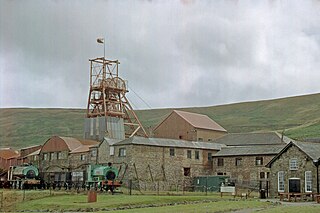
Hombourg-Haut is a commune located in the department of Moselle, region of Grand Est, in the cultural and historical region Lorraine, north-eastern France.

Forbach is a commune in the French department of Moselle, northeastern French region of Grand Est.

Big Pit National Coal Museum is an industrial heritage museum in Blaenavon, Torfaen, Wales. A working coal mine from 1880 to 1980, it was opened to the public in 1983 under the auspices of the National Museum of Wales. The site is dedicated to operational preservation of the Welsh heritage of coal mining, which took place during the Industrial revolution.

La Grand-Combe is a commune in the Gard department in southern France.

Petite-Rosselle is a commune in the Moselle department of the Grand Est region in north-eastern France. The commune is separated from neighbouring Großrosseln to its west by the small river Rossel, which forms the border between France and Germany. It has 6,322 inhabitants (2018).

The Wendel family is an industrialist family from the Lorraine region of France. During the 19th and 20th centuries, the family gained both industrial and political power. As a result, the family also attracted controversy as an icon of French capitalism. Following the nationalization of the French steel industry in 1978, the family formed a successful investment company. The family owns a significant stake in Wendel S.A.

Farébersviller is a commune in the Moselle department in Grand Est in north-eastern France.

Stiring-Wendel is a commune in the Moselle department in Grand Est in north-eastern France, wedged between Forbach, Schœneck, Spicheren and Saarbrücken.

The Saint-Étienne Mine Museum is a French museum founded in 1991 in the city of Saint-Étienne in the French department of the Loire situated in the Rhône-Alpes region. It presents the facilities of a former coalmine. The site is registered as a historical monument since 2011.

The arrondissement of Forbach-Boulay-Moselle is an arrondissement of France in the Moselle department in the Grand Est region. It has 169 communes. Its population is 243,054 (2016), and its area is 1,283.3 km2 (495.5 sq mi).

The Compagnie des mines d'Anzin was a large French mining company in the coal basin of Nord-Pas-de-Calais in northern France. It was established in 1756 and operated for almost 200 years.

The Compagnie des mines de Bruay was a French coal extraction company which operated in the Nord-Pas de Calais Mining Basin between 1850 and 1946. It operated 18 mine shafts at eight production sites in Bruay-la-Buissière, Haillicourt, Divion and Houdain.

Humbert de Wendel was a French steelmaker who came from a long line of Lorrainian industrialists. He and his brother François de Wendel were among the leaders of the French steel industry from before World War I until after World War II.

The Société des aciéries de Longwy was a steelworks located in Longwy, Meurthe-et-Moselle, France.

Charles de Wendel was a French steel manufacturer in Lorraine and a deputy in the French legislative assembly.

Guy de Wendel was a French politician from a family of Lorraine industrialists, who served as deputy and then senator for Moselle, Lorraine. After the fall of France in World War II (1939–45), he voted in favour of granting Marshal Pétain the constitutional powers he had requested.

François de Wendel was a French industrialist and politician. He inherited the leadership of a major steel manufacturer in Lorraine at a time when it was part of Germany, and in Meurthe-et-Moselle in France to the west. He entered national politics just before World War I (1914–18), holding office first as a deputy and then as a senator until after the defeat of France in World War II (1939–45). His position as a deputy and also as head of the largest industrial enterprise in France inevitably led to accusations that he was manipulating policy in favor of his business empire.

Camille Cavallier was a French industrialist who directed the Pont-à-Mousson iron works in Lorraine in the first quarter of the 20th century, specializing in making cast iron pipes. He came from a poor family but obtained a good technical education and joined the iron maker as an employee in 1874. He rose rapidly through the ranks, and started to acquire shares. Soon after taking charge of the company he became the largest shareholder. He quadrupled production in the years leading up to World War I (1914–18). The company was devastated by the war, but Cavallier managed to bring production back up to prewar levels before his death.

Louis-Georges Mulot was a French engineer and entrepreneur. He helped create numerous artesian wells in Paris and was the founder of the Compagnie des mines de Dourges; one of the first extensions of the Nord-Pas de Calais Mining Basin.

The SNCF Class CC 14100 was a class of 25 kV 50 Hz AC electric centre cab locomotives designed to haul heavy freight trains in the northeast of France and cross-border traffic into Luxembourg. A total of 101 locomotives were produced, numbered CC 14101 – CC 14202.





















